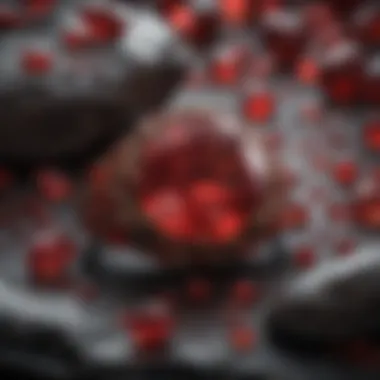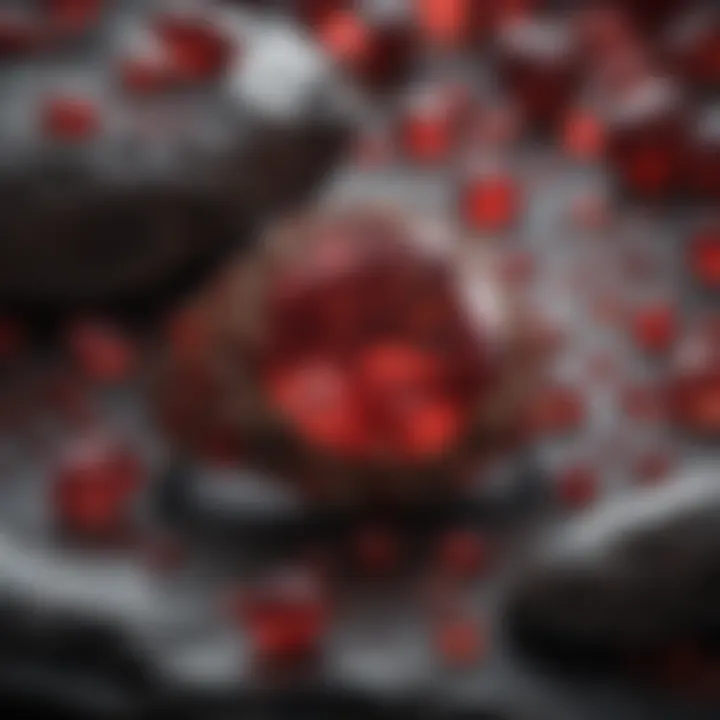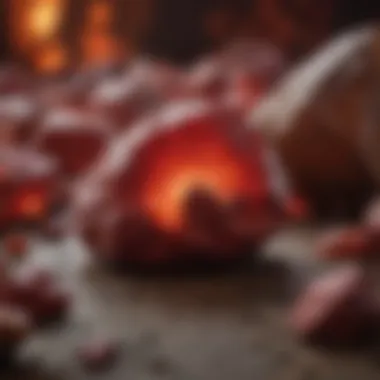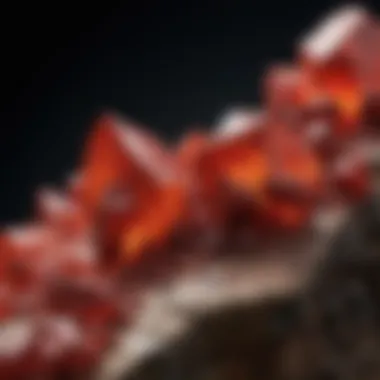Exploring the Significance of Red Mineral Stones


Intro
Red mineral stones are not merely geological curiosities; they carry deep significance across cultures and epochs. These stones, which embody a rich tapestry of geological processes, aesthetic qualities, and historical narratives, provide insights into both the natural world and human aspirations. Understanding red minerals requires a journey through their origins, identification, and cultural meanings, allowing for a profound appreciation of their role in both history and modern applications.
History and Origins
Overview of Collectibles, Rocks, and Fossils
Throughout human history, red minerals have captivated the attention of collectors and enthusiasts alike. From their early use as decorative items to their incorporation in rituals and beliefs, these stones possess a dual aspect of beauty and utility. Collectors treasure these stones not only for their stunning appearance but also for the stories they tell regarding the environment from which they originated.
Many red minerals, like rubies and garnets, have been used in jewelry and ornaments for centuries. Their electric hues symbolize power, love, and passion in various cultures. This fascination with red stones reflects humanity's tendency to ascribe meaning and value to natural objects, effectively integrating them into social and cultural contexts.
Historical Significance and Cultural Impact
Red minerals have played pivotal roles in ancient civilizations. For example, ancient Egyptians highly valued carnelian, which they believed had protective qualities and designated it for use in burial rituals. Similarly, in China, jade's green hues are often celebrated, yet red coral holds an equally revered place, respected for its supposed magical properties.
The presence of red gemstones in artifacts and relics indicates their socioeconomic importance during various periods. This history is not confined only to ancient practices; modern applications in art, design, and fashion continue the tradition of using these stones as symbols of status and beauty. The enduring appeal of red mineral stones in both historical and contemporary contexts mirrors society's ongoing relationship with the natural world.
"Minerals are both architects of our planet and the storytellers of our history."
Identification and Classification
Guide to Identifying Rocks and Fossils
Identifying red mineral stones involves a combination of visual inspection and scientific analysis. For instance, the hardness, luster, and color saturation play crucial roles in distinguishing among varieties. A reliable tool for identification is the Mohs scale of mineral hardness, which ranks minerals based on their ability to withstand scratching.
Other methods include observing the crystal structure under a microscope and conducting specific gravity tests. Each technique adds layers of knowledge, enriching a collector’s understanding and appreciation of their specimens.
Common Types and Variations
There is a diversity of red minerals, each with distinct characteristics:
- Ruby: Celebrated for its brilliance and rarity, rubies are a result of corundum containing chromium.
- Garnet: Available in various shades of red, garnets often form in metamorphic rocks and are used in various applications, from jewelry to abrasives.
- Spinel: Often mistaken for ruby, spinel presents vibrant red colors and offers a unique alternative in the realm of precious stones.
Understanding these varieties aids in developing a discerning eye that not only identifies red minerals but also appreciates their specific attributes.
The study of red mineral stones, enriching both scientifically and culturally, forms a bridge between nature and human expression, inviting both enthusiasts and scholars alike into its captivating fold.
Preamble to Red Mineral Stones
Red mineral stones captivate many for their vivid color and diverse applications. These stones hold significant value not only in geology, but also in culture and aesthetics. Understanding red minerals involves recognizing their characteristics, origins, and relevance. This article aims to explore these elements thoroughly, giving readers valuable insights whether they are collectors, hobbyists, or merely curious.
Defining Red Mineral Stones
Red mineral stones are naturally occurring geological materials that have a dominant red coloration. This hue can arise from the presence of iron oxide or other trace elements. Common examples include ruby, garnet, and jasper. Each type of mineral exhibits unique properties regarding hardness, translucency, and appearance, which further defines its usage and appeal. The definition also extends to the context in which these minerals are found, as some are prevalent in specific geographic regions.
Geological Overview
The geological formation of red minerals is a complex process influenced by various factors. The Earth’s crust hosts a diverse range of minerals shaped over millions of years by the forces of nature. Red minerals typically form in specific environments that include metamorphic and igneous contexts.
- Metamorphic Processes: During metamorphism, heat and pressure transform existing rocks, leading to the creation of new mineral structures. This process often results in the formation of garnets.
- Igneous Activity: Magma cools and solidifies to form igneous rocks. Some minerals crystallize from molten rock, and this includes red varieties such as ruby.
Understanding these geologic processes informs users about the origins of various red minerals. Each mineral's formation can influence its rarity, quality, and, consequently, its market value. Therefore, knowing the geological backdrop of red minerals is crucial for any collector or enthusiast in evaluating these beautiful stones.
Types of Red Minerals
The categorization of red minerals is essential in understanding their properties, applications, and significance. Each type, whether common or rare, contributes uniquely to our knowledge and appreciation of red mineral stones. By examining these variants, we can gain insights into their geology, value, and usage. In this section, we will explore the common red minerals such as Ruby, Garnet, and Jasper, as well as rare finds like Red Beryl and Spinel. These discussions will help us appreciate not only their physical characteristics but also their cultural and commercial relevance.
Common Variants
Ruby
Ruby is one of the most esteemed red minerals. This gemstone is valued for its rich red hue, which is attributed to the presence of chromium in its chemical composition. Its brilliance and durability make Ruby a popular choice in jewelry. The hardness of Ruby, rated at 9 on the Mohs scale, adds to its appeal as it resists scratches effectively.
A distinguishing feature of Ruby is its fluorescence, which allows the stone to exhibit a vibrant glow under UV light. This quality enhances its desirability among collectors and enthusiasts.
However, the high market demand for Ruby can lead to significant price fluctuations, especially for stones with exceptional clarity and color. Overall, Ruby stands out as a symbol of luxury and prestige in both historical and modern contexts.
Garnet
Garnet is another red mineral, often found in various shades from deep red to fiery orange. It serves as a birthstone for January and carries metaphysical associations with energy and regeneration. Unlike Ruby, Garnet is a group of minerals with similar properties, thus offering a wider range of colors and forms.
One of Garnet's main advantages is its availability when compared to other red stones. It is more accessible to collectors, allowing them to explore different varieties without significant financial burden. The unique aspect of Garnet lies in its use in abrasives due to its hardness, which ranks around 7.5 to 8 on the Mohs scale.


However, its lesser hardness compared to Ruby can limit its use in high-end jewelry. Still, Garnet remains a valuable addition to any collection, appreciated for its diversity and beauty.
Jasper
Jasper is recognized for its earthy tones and patterns, often presenting as a more muted red. Unlike garnet and ruby, Jasper is a chalcedony variant, composed primarily of silicon dioxide. This makes it less valuable in the jewelry market but helps it find a place in decorative items and carvings.
The appeal of Jasper comes from its unique patterns and colors, offering an organic feel that resonates with nature lovers. Its relatively low hardness of about 6.5 to 7 makes it easier to work with in crafting.
However, given its lower market value, collectors may find it less desirable compared to the more precious stones. Jasper serves as a reminder that beauty can be found in simplicity, making it appealing to various audiences.
Rare Finds
Red Beryl
Red Beryl, also known as Bixbite, is among the rarest mineral finds. Its striking red color comes from trace amounts of manganese, resulting in a unique, vibrant appearance. Red Beryl is significantly rarer than Ruby, making it a highly sought-after stone among serious collectors and gemologists.
The most remarkable attribute of Red Beryl is its exceptional brilliance and clarity, often surpassing that of other red stones. With a hardness of around 7.5 on the Mohs scale, it is relatively durable, although less than Ruby. This rarity makes Red Beryl valuable and commands high prices in the marketplace, appealing primarily to niche collectors who appreciate rare gems.
On the downside, its scarcity means that many enthusiasts may never have the opportunity to hold or see a genuine specimen, adding to its mystique and exclusivity in the mineral community.
Spinel
Spinel is frequently confused with Ruby due to its similar color, yet it is distinct in its own right. This mineral comes in a variety of colors, including a brilliant red. Spinel's hardness, rated at 7.5 to 8 on the Mohs scale, makes it a durable option for jewelers, surpassing many other gemstones in resilience.
One of the advantages of Spinel is its affordability compared to Ruby and Red Beryl. Spinel's unique feature is its high refraction index, allowing it to exhibit exceptional brilliance and fire.
Despite its advantages, Spinel has historically been underrated, often overlooked in favor of more well-known gemstones. However, its rising recognition in recent years is a trend worth noting for collectors. As awareness grows, Spinel may increasingly occupy a role of significance in discussions about red mineral stones.
Geological Formation of Red Minerals
The geological formation of red minerals is a crucial aspect in understanding their unique character and aesthetic appeal. This section delves into the chemical composition and the processes responsible for the formation of these captivating stones. Recognizing the foundational elements that give rise to red minerals helps enthusiasts appreciate their value and significance. Through this exploration, we can discern important factors that influence both the minerology and market demand for these gemstones.
Chemical Composition
The chemical composition of red minerals plays a vital role in determining their physical properties, as well as their color and luster. These minerals often contain elements like aluminum, iron, and chromium, which contribute to their vibrant hues. For example, ruby, a famous red mineral, derives its color primarily from chromium. Meanwhile, garnets may exhibit various shades of red depending on their specific chemical variations. Understanding the specific elements involved helps collectors identify and classify different types of red minerals accurately, enhancing their appreciation of the stones.
Formation Processes
Metamorphism
Metamorphism involves the transformation of existing rocks through heat, pressure, and chemically active fluids. This process is crucial for the creation of many red minerals. During metamorphism, minerals undergo changes that often enhance their color and structural integrity. The heat and pressure conditions can cause red minerals like garnets to crystallize, leading to their distinctive appearance.
A key characteristic of metamorphism is its ability to develop gemstones from previously formed rocks. This is significant because it contributes to the multifaceted nature of red minerals. One unique feature of this process is the potential for the formation of inclusions within the stones, which can tell a story of the mineral's journey through geological time. However, while metamorphism can produce stunning gemstones, the conditions required may limit the locations where these stones are found.
Igneous Activity
Igneous activity refers to the formation of rocks through the cooling and solidification of magma or lava. This process is also significant in generating red minerals. For instance, minerals like red beryl form in certain volcanic environments, where extreme conditions lead to the crystallization of these exceptional gems.
A defining characteristic of igneous activity is its often explosive nature, carrying a variety of minerals to the earth's surface. This type of formation is beneficial as it frequently leads to the discovery of rare gemstones. However, while igneous activity can create breathtaking red minerals, the process can also lead to instabilities which may hinder mineral recovery and accessibility in some scenarios.
Identification Techniques
Identification Techniques for red mineral stones is a critical aspect of understanding their properties and applications. Knowing how to accurately identify these stones not only aids collectors in ensuring they have genuine items, but also enhances their appreciation of the geological processes at play.
Visual Characteristics
Visual characteristics include color, luster, clarity, and texture. The vibrant shades of red in these minerals can vary significantly. For instance, ruby is recognized for its deep crimson hue, while garnet can present itself in a range from brownish red to bright red. Factors such as inclusions, which are other materials embedded within the mineral, can affect its appearance and help distinguish between types. Additionally, observing the luster, whether it is glassy, dull, or metallic, gives insight into the mineral's composition.
Understanding visual characteristics is fundamental because it forms the basis for preliminary identification before conducting more invasive tests. Collectors can easily visually classify red minerals, enhancing their collecting experience.
Testing Methods
Testing methods provide an objective means to verify the identity of red minerals. Various techniques can be employed, two of which are hardness tests and streak tests.
Hardness Tests
Hardness Tests measure a mineral's resistance to scratching. This assessment is significant for red minerals because different types exhibit varying levels of hardness. For example, ruby ranks at 9 on the Mohs scale, which makes it one of the hardest minerals, while garnet typically falls between 6.5 and 7.5.
The key characteristic of hardness tests is their simplicity and direct application. They provide immediate insights into a mineral's identity based on how it interacts with other materials. This method is popular among collectors because it can be done with minimal tools, often just requiring items of known hardness, like a fingernail or a steel file. However, a disadvantage is that it can cause minor damage to softer stones, which may affect their visual appeal.
Streak Tests
Streak Tests involve rubbing a mineral across a porcelain plate to observe the color of the powder left behind. This method is highly beneficial as the streak color is often more consistent than the surface color of the mineral, aiding in identification.
The unique feature of streak tests is their effectiveness in differentiating between minerals that may appear similar in color. For instance, some red minerals may look alike but will produce different streak colors, assisting in more accurate identification.


However, like with hardness tests, there are slight downsides. Some minerals may not leave a streak due to their hardness or other characteristics. Thus, while it's a useful technique, it is best utilized in combination with other methods for comprehensive analysis.
Understanding these identification methods is essential for any enthusiast in the realm of red mineral stones, as they not only ensure authenticity but also deepen the collector's connection to their specimens.
Applications of Red Minerals
Red minerals hold a significant place in various domains, primarily due to their aesthetic appeal and unique properties. This section focuses on the practical applications of these stones in jewelry and in industry. Understanding these applications informs both collectors and enthusiasts about the functional values and the sheer beauty that red minerals can offer.
Jewelry and Ornaments
The allure of red minerals in jewelry is hard to overlook. From the brilliant hues of ruby to the earthy tones of garnet, these stones are sought after for their visual depth and symbolism. Historically, red stones have been associated with love, power, and protection, making them a popular choice for engagement rings and other fine jewelry.
When crafting jewelry, the durability and brilliance of red minerals play a critical role. For instance, rubies, known for their hardness and vibrant color, have become a staple for luxury jewelry. Their ability to resist scratches ensures that they can endure daily wear, making them not just beautiful but also practical.
Additionally, red minerals often have significant cultural meanings. In many cultures, they are believed to bring good luck and status. The combination of beauty and meaning contributes to their continuous popularity in the jewelry market.
Industrial Uses
Beyond their decorative roles, red minerals also find substantial applications in industry, particularly in the production of cutting tools and construction materials.
Cutting Tools
Red minerals such as garnet are utilized to make abrasive cutting tools. The key characteristic of garnet is its hardness, which allows it to cut through various materials. This trait makes garnet abrasive a beneficial choice in industrial applications. Industries benefit from its effectiveness in machining and surface preparation processes.
The unique feature of garnet abrasive is its ability to generate minimal dust in operation. This characteristic enhances safety and efficiency, making it preferable for many operations. However, the availability and cost of high-quality garnet can disadvantage some manufacturers, leading them to consider alternative materials in particular contexts.
Construction Materials
Red minerals also play a vital role in construction. Certain types, like red sandstone, are valued for their aesthetic appeal and structural properties. Builders choose red minerals for their thermal insulation capabilities and durability, which are essential for robust construction.
In this context, the unique feature of red minerals is their natural color, which can enhance the visual aspects of buildings. This is not only attractive but often gives a distinctive character to architectural structures. However, depending on geographic availability, the usage of red minerals in construction might present logistical challenges, which can affect their adoption across various regions.
"Red minerals are not only appealing, but their applications in industry reveal their essential role in modern practices."
In summary, the applications of red minerals extend far beyond aesthetics. Their utility in jewelry and industry underscores their importance, enriching both the artistic and practical realms. Collectors and enthusiasts should appreciate the broad scope of uses red minerals have, recognizing both their beauty and their functional contributions.
Cultural Significance of Red Minerals
The cultural significance of red minerals extends far beyond their aesthetic appeal. These stones have played a crucial role in various societies and cultures throughout history, often symbolizing power, status, and spirituality. Understanding this significance can enhance one’s appreciation of these minerals and their roles in rituals, art, and personal adornment. This section will examine the historical contexts and modern interpretations of red minerals, highlighting their deep-seated influence in human culture.
Historical Context
Usage in Ancient Civilizations
In ancient civilizations, red minerals such as garnet and ruby were not merely decorative items; they were also used for their supposed mystical properties. These stones often appear in royal regalia and funeral artifacts, marking their importance as symbols of wealth and protection in the afterlife. For instance, Egyptians used carnelian in burial jewelry, believing it would provide strength in the next world. This significance underscores red minerals' role in establishing social hierarchies and defining cultural identities. Such uses show how these stones were a beneficial choice, as they were seen not only as adornments but also as conduits for spiritual energy.
Religious Symbolism
Red minerals have deep connections with various religious beliefs. In many cultures, red is associated with vigor, passion, and the life force. For example, in Christianity, the carmine color of certain stones reflects Christ's blood, symbolizing sacrifice and redemption. This powerful symbolism invites reflection and connection to one's spirituality, making these stones attractive choices for rituals and celebration. However, reliance on such symbolism can lead to misinterpretation over time, which may misrepresent the cultural nuances of red minerals in different religions.
Modern Interpretations
Artistic Trends
In contemporary art and design, red minerals continue to inspire creativity. Artists frequently incorporate these stones into their work, symbolizing passion and emotional intensity. The vibrancy of these materials attracts artists seeking to convey profound themes. This characteristic makes red minerals a popular choice in modern artistry. However, the challenge lies in balancing artistic intention with respect for the cultural heritage of these materials. Ensuring awareness of their historical significance is crucial to honoring their legacy while expressing modern interpretations.
Collecting Trends
The trend of collecting red minerals has gained momentum among enthusiasts and collectors alike. Individuals are drawn to the unique features and variations of these stones, leading to a robust market for rarer specimens. The fascinating history and stories behind each piece contribute to its appeal. However, collectors must remain vigilant about the ethical sourcing of these minerals. Supporting sustainable practices ensures that the beauty of red minerals is preserved for future generations, making collecting not just a personal endeavor but a responsible choice for the community as a whole.
"Red minerals symbolize not just beauty but also resilience, community, and a rich tapestry of human experience."
These cultural threads showcase the multifaceted significance of red minerals in both past and present contexts. As enthusiasts delve into the world of red minerals, they uncover layers of meaning that enrich their appreciation for these prized geological wonders.
Caring for Red Mineral Stones
Caring for red mineral stones is crucial for preserving their beauty and integrity. These stones are not only valued for their aesthetic qualities but also for their geological significance. Proper care extends the lifespan of these minerals, ensuring they can be enjoyed by collectors and enthusiasts for years to come. It is essential to understand the different methods of cleaning and storage to protect these valuable specimens.
Cleaning Methods
Cleaning red mineral stones is a delicate task. The cleaning approach depends on the type of mineral and its specific properties. Here are some effective cleaning methods:
- Gentle Rinsing: Using lukewarm water, rinse the stone to remove dust and dirt. Avoid hot water, as it can cause thermal shock.
- Soft Brushes: Employ a soft-bristled brush, such as a toothbrush, to remove debris from crevices. Ensure the brush is not abrasive to avoid scratching.
- Mild Soap: If needed, a solution of mild soap and water can be effective. Rinse thoroughly afterward to remove any soap residue.
- Avoid Chemicals: Harsh chemicals can damage the stone’s surface. Steer clear of bleach or acidic substances that can corrode the minerals.
- Drying: Air dry the stones completely before storing. This prevents moisture accumulation, which can lead to mineral corrosion over time.


Cleaning not only beautifies the stones but also helps in examining them closely for any potential damage. Additionally, keeping them clean facilitates better display and appreciation.
Storage Recommendations
Storage is as important as cleaning when it comes to caring for red mineral stones. Proper storage measures can prevent damage from environmental factors and physical contact. Here are some considerations for effective storage:
- Separate Storage: Store each stone individually to prevent scratching and chipping. Use soft cloth pouches or separate compartments in boxes.
- Temperature Control: Keep stones in a stable environment with moderate temperatures. Extreme heat or cold can cause fractures or changes in appearance.
- Humidity Levels: Maintain optimal humidity levels to prevent any moisture-related issues. Ideally, the humidity should be kept around 30-50%.
- Avoid Sunlight: Direct sunlight can fade colors in some minerals. Store stones in a dark, cool place away from direct light.
- Regular Checks: Periodically check stored stones for any signs of damage or degradation. Addressing issues early can prevent further harm.
By following these cleaning and storage methods, collectors can protect their red mineral stones effectively. Well-cared-for stones will retain their beauty and value, enriching the collector's experience while ensuring their significance is preserved for future generations.
Red Mineral Stones in the Marketplace
The marketplace for red mineral stones is vibrant and complex. This sector encapsulates both the aesthetic and practical values of these minerals. Understanding the dynamics of this market is crucial for collectors, enthusiasts, and those looking to invest. The demand for red minerals spans jewelry, art, and various industrial applications, making their valuation not only a reflection of natural beauty but also of economic significance.
Market Valuation
Factors Affecting Price
Several factors determine the price of red mineral stones. These factors can be intrinsic or extrinsic.
- Rarity: Some stones, like Red Beryl, are difficult to find. Their scarcity increases demand and thus elevates price.
- Quality: The color saturation, clarity, and cut significantly influence pricing. Higher-quality stones fetch better market values.
- Market Trends: Current trends can sway prices dramatically. For example, during a resurgence in vintage jewelry, the price for garnets might rise.
- Source Location: Provenance contributes to desirability. Stones from well-known locations, such as rubies from Myanmar, can command premium prices.
Overall, understanding these elements allows individuals to navigate the market effectively. It is vital for collectors to consider these aspects when making purchases, as it can lead to better investment decisions.
Assessment Techniques
Assessment techniques are integral in evaluating red minerals. Professionals often rely on a mix of visual inspection and scientific methods.
- Visual Inspection: This involves looking for imperfections and evaluating color. A true expert can discern subtle variations that affect value.
- Gemological Testing: Tools like refractometers and spectroscopes provide precise data on a stone’s properties.
- Certification: Documents from recognized institutions affirm the stone's value and authenticity.
These techniques are beneficial because they provide clarity in valuation. However, they can require expertise and equipment that are not always accessible to casual buyers.
Ethical Sourcing
With growing awareness of ethical repercussions, sourcing red mineral stones responsibly is crucial. Many consumers are now interested in the origin of the stones they buy. Ethical sourcing involves ensuring that mining practices do not exploit workers or harm the environment.
- Transparency in Supply Chains: Buyers value companies that disclose how and where their stones are sourced.
- Fair Labor Practices: Ensuring that miners are paid fairly is important for sustainability and community welfare.
- Environmental Considerations: Responsible mining operations use methods that mitigate damage to ecosystems.
The marketplace is increasingly leaning towards ethics. Consumers who prioritize these values often seek stones that meet high ethical standards, which can affect their purchasing decisions.
Understanding the marketplace for red mineral stones allows enthusiasts and collectors to make informed choices, ensuring that they not only acquire beautiful specimens but also support ethical practices.
Future Trends in Red Mineral Research
The study of red mineral stones is not static; it evolves with advancements in technology and methods of inquiry. Future research trends hold the promise to unlock new discoveries, enhance our understanding of these valuable minerals, and broaden the scope of their application. The exploration of red minerals such as ruby or garnet can provide insights into geological conditions and even ancient Earth processes. A comprehensive approach could contribute significantly to fields such as geology, mineralogy, and even art history.
New Discoveries
New discoveries are poised to transform our perceptions of red mineral stones. Recent explorations in remote areas have unveiled deposits previously unknown, offering fresh specimens to consider. For instance, the discovery of new gemstones can challenge existing classifications or reveal unique characteristics. Researchers use modern geological techniques, such as satellite imagery and geochemical analyses, to locate and study these stones. These methods provide a clearer picture of mineral distribution and guide future mining endeavors. Moreover, the intersection of red mineral research and technology fosters collaboration across multiple scientific disciplines.
Such discoveries also hold economic implications. By identifying new sources of red minerals, we can anticipate shifts in market dynamics. This can potentially lower prices or open up avenues for artisanal mining, promoting local economies. The continuous exploration guarantees that the field remains vibrant and that knowledge keeps expanding.
Scientific Advancements
Scientific advancements play a crucial role in the future of red mineral research. Enhanced analytical tools, especially in spectroscopy and microscopy, allow for precise determination of mineral compositions and structures. For example, energy-dispersive X-ray spectroscopy (EDX) can identify the elemental composition of mineral samples. These advancements enable more comprehensive research, contributing to an understanding that can inform both academic and practical applications.
Additionally, the improvement in computational modeling can provide insights into the formation and stability of red minerals under varying environmental conditions. Such modeling facilitates deeper investigation into the histories of these minerals and their roles in Earth's geological processes. As research methods become more refined, the integration of data from diverse sources will enable the creation of more accurate geological models.
"Future trends in red mineral research will bridge the gap between tactical exploration and theoretical understanding, driving a renaissance in our appreciation of these geological treasures."
In summary, the future of red mineral research is promising, with both new discoveries and scientific advancements set to enhance our comprehension and appreciation of these fascinating natural materials. Engaging with these trends will not only satisfy intellectual curiosity but also sustain interest in the conservation and ethical sourcing of red minerals.
Finale
Red mineral stones hold a vast significance that extends beyond their physical beauty. Throughout this article, we have explored their geological composition, various types, and cultural importance. As we conclude, it is essential to underscore the multifaceted role these minerals play in both scientific and societal contexts.
Understanding red minerals, such as Ruby and Garnet, informs not only geological studies but also economic aspects within the mineral market. Their unique properties and applications in jewelry and industry make them highly sought after, influencing market values and ethical sourcing trends. Moreover, the appreciation for red minerals in art and personal adornment reflects human emotions and cultural legacies, bridging the past with the present.
"The vibrant hues and intricate characteristics of red minerals have captivated civilizations for centuries."
We realize that recognizing red mineral stones goes beyond mere aesthetics. It requires knowledge of their origins, valuation, and care. Ultimately, this knowledge enriches our experience as collectors and enthusiasts, prompting us to engage more thoughtfully with these remarkable resources.
Key Takeaways
- Red minerals, including Ruby and Jasper, are critical for understanding geological processes.
- The market for these stones is influenced by factors such as rarity and cultural significance.
- Ethical sourcing has become a priority in the mineral marketplace.
- Care and maintenance are vital for preserving the value and beauty of these stones.
Encouragement for Continued Exploration
Red mineral stones offer endless avenues for exploration. As new discoveries emerge and technology advances in geological research, the potential for deeper understanding grows. Collectors and enthusiasts are encouraged to delve into further studies, seek out reputable sources, and connect with others interested in this fascinating field.
Whether through academic pursuits, field exploration, or community engagement, the journey into the world of red minerals promises to be rewarding. Each stone offers a story, a connection to the earth, and insights into our histories. Uncovering these layers enhances appreciation, making the exploration of red minerals an ongoing and enriching endeavor.



